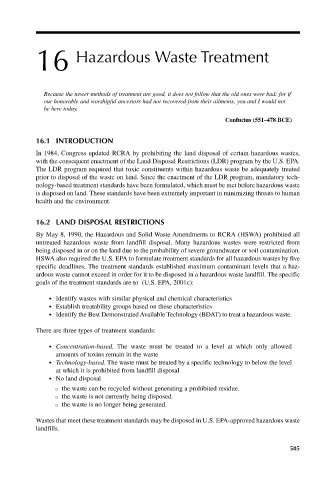Page 534 - Materials Chemistry, Second Edition
P. 534
CAT3525_C16.qxd 1/27/2005 12:42 PM Page 505
16 Hazardous Waste Treatment
Because the newer methods of treatment are good, it does not follow that the old ones were bad: for if
our honorable and worshipful ancestors had not recovered from their ailments, you and I would not
be here today.
Confucius (551–478 BCE)
16.1 INTRODUCTION
In 1984, Congress updated RCRA by prohibiting the land disposal of certain hazardous wastes,
with the consequent enactment of the Land Disposal Restrictions (LDR) program by the U.S. EPA.
The LDR program required that toxic constituents within hazardous waste be adequately treated
prior to disposal of the waste on land. Since the enactment of the LDR program, mandatory tech-
nology-based treatment standards have been formulated, which must be met before hazardous waste
is disposed on land. These standards have been extremely important in minimizing threats to human
health and the environment.
16.2 LAND DISPOSAL RESTRICTIONS
By May 8, 1990, the Hazardous and Solid Waste Amendments to RCRA (HSWA) prohibited all
untreated hazardous waste from landfill disposal. Many hazardous wastes were restricted from
being disposed in or on the land due to the probability of severe groundwater or soil contamination.
HSWA also required the U.S. EPA to formulate treatment standards for all hazardous wastes by five
specific deadlines. The treatment standards established maximum contaminant levels that a haz-
ardous waste cannot exceed in order for it to be disposed in a hazardous waste landfill. The specific
goals of the treatment standards are to (U.S. EPA, 2001c):
● Identify wastes with similar physical and chemical characteristics
● Establish treatability groups based on these characteristics
● Identify the Best Demonstrated Available Technology (BDAT) to treat a hazardous waste.
There are three types of treatment standards:
● Concentration-based. The waste must be treated to a level at which only allowed
amounts of toxins remain in the waste
● Technology-based. The waste must be treated by a specific technology to below the level
at which it is prohibited from landfill disposal
● No land disposal
the waste can be recycled without generating a prohibited residue.
the waste is not currently being disposed.
the waste is no longer being generated.
Wastes that meet these treatment standards may be disposed in U.S. EPA-approved hazardous waste
landfills.
505

